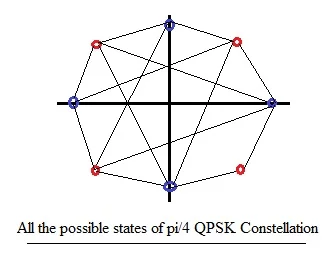Difference between QPSK vs OQPSK vs pi/4QPSK
All these are modulation schemes used in wireless digital communication systems. OQPSK and pi/4 QPSK are variants of the basic QPSK modulation schemes. They are widely used based on their unique individual phase transition functionalities compare to one another. This page explain these modulation types and explain difference between QPSK vs OQPSK vs pi/4QPSK.
QPSK
 Fig1. QPSK-OQPSK block diagram
Fig1. QPSK-OQPSK block diagram
As mentioned Quadrature Phase Shift Keying is referred as QPSK. Here maximum phase shift is limited to about 90 degree.
In QPSK, first input bit stream is split into two bit streams referred as odd and even. These streams are applied simultaneously to the mixers.
Refer BPSK vs QPSK page for power spectrum density of QPSK modulated spectrum.
OQPSK
Offset Quadrature Phase Shift Keying is referred as OQPSK. Here maximum phase shift is about +/- 90 degree.
In OQPSK, after splitting the bit stream into odd and even, one bit stream is made offset by 1 bit period with respect to the other. After this, the direct and shifted bit streams are fed to the mixers.
Power spectral density(PSD) of OQPSK modulated spectrum is same as QPSK. Pls. note offset in bit stream will not have any effect on the PSD.
 Fig.2 QPSK-OQPSK time domain signal waveforms
Fig.2 QPSK-OQPSK time domain signal waveforms
As shown in the fig.2, as transitions are offset for both the odd and even bit streams at any given time; only one of the bit stream can change the values.
As shown above in the constellation diagram, phase transition goes through the origin and this results into suddon phase reversal in the time domain signal envelope. When such signal goes through the nonlinear amplification will result into spectrum widening. To overcome regeneration of sidelobes and spectrum widening, linear amplifier is employed. But linear amplifiers are less efficient. Hence OQPSK has been developed. OQPSK prevents phase transition from the origin by shifting one stream by a bit period and allowing only one bit to change between the transitions.
pi/4 QPSK
pi/4 QPSK modulation scheme is obtained by adding additional π/4 phase shift in the phase of the carriers of the symbols.
| Input Bits | QPSK Phase (φk) | OQPSK Phase (φk) |
|---|---|---|
| 00 | O degree | -π/4 |
| 01 | π/2 | 3π/4 |
| 10 | π | -3π/4 |
| 11 | 3π/2 or -π/2 | π/4 |
Table mentions phase output values for different input bit combinations for both the QPSK and pi/4QPSK modulations.
 Fig.3 pi/4 QPSK constellation diagram
Fig.3 pi/4 QPSK constellation diagram
π/4 shifted version of QPSK is referred as pi/4 QPSK. With this modulation compromise between QPSK and OQPSK is done and maximum phase transition of about 135 degree is achieved.
In the presence of the multipath spread and fading conditions, pi/4 QPSK perform better than OQPSK. This signal is demodulated in coherent and non-coherent fashion and hence the design of the receiver will be simple. Figure depicts all the possible states of the &pi/4QPSK constellation.
The table below summarizes QPSK, OQPSK and pi/4 QPSK modulation types.
| QPSK | OQPSK | pi/4 QPSK |
|---|---|---|
| phase changes of +/- 90 and +/-180 degrees | phase changes of +/- 90 exist | Maximum phase change of +/-45 and +/-135 |
| Requirements of linear amplifier as non linear amplifier cause spectral regrowth because of abrupt +/-180 degree transitions of the both bits change the phase at the same time. | less demands of linear amplifiers, efficient non linear amplifier can be employed and they do not cause much spectral regrowth, as one of the bits changes the phase at a time and occurs twice during the symbol period with half the intensity of QPSK | Phase transitions avoid zero crossing. This will remove design constaints on the amplifier, non linear amplifier can be employed |
| Null Bandwidth is 1.0 X Data rate | Same as QPSK | Same as QPSK |
| Bandwidth containing 90% of power is in 0.8 X Data rate | Same as QPSK | Same as QPSK |
| Power spectral density falls of as inverse second power of frequency | Same as QPSK | Same as QPSK |
| 99% of power is contained in 1.0 X data rate | Same as QPSK | Same as QPSK |
| Amplitude variations are of the order of 30dB | Amplitude variation are of the order of 3 dB | - |
| Main lobe to side lobe suppression is poor | Same as QPSK | Same as QPSK |
| Main lobe width is 1.0 X data rate | Same as QPSK | Same as QPSK |
Useful Links
what is modulation
MSK and GMSK modulation
BPSK modulation
8-PSK modulation
QPSK modulation
QAM modulation
BPSK vs QPSK -Difference Between BPSK and QPSK modulation techniques.
QPSK vs OQPSK vs pi/4QPSK-Difference between QPSK,OQPSK and pi/4QPSK modulation techniques
Differential Encoder and Decoder
What is Difference between
difference between OFDM and OFDMA
Difference between SC-FDMA and OFDM
Difference between SISO and MIMO
Difference between TDD and FDD
FDMA vs TDMA vs CDMA
FDM vs TDM
CDMA vs GSM
